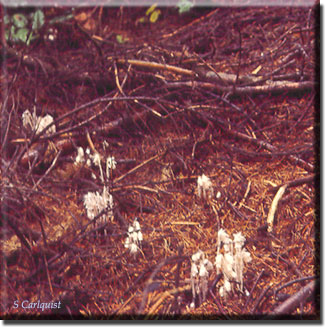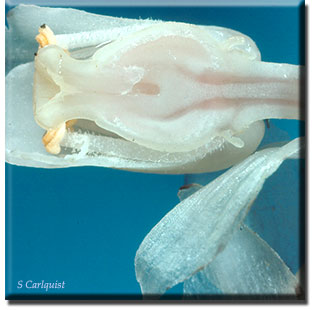Monotropa uniflora
If you see a sight like this in a conifer forest in the northern part of North America, Canada, and even some parts of Asia, you have encountered Monotropa uniflora, the Indian pipe or ghost plant. If you're lucky, you may find a large clump of the Indian Pipe. The plant is entirely white, and each step is tipped by a single flower. If the plant is bruised or dries up, it turns dark brown or black. The fact that the flowers bend over probably relates to the wet places where they grow: if the flowers pointed upward, they might collect rainwater, and the nectar that they offer visiting insects would be diluted. The pollen grains would also be wet and wouldn't cling to visiting insects properly.
The indian pipe is a flowering plant, but it isn't green, so how does it get its food? Even today, you see misinformation about that. People thought that it lived on decaying leaves and called it a saprophyte. Today we know that it has short, stubby roots that contain fungi. And the fungi, extend in a web-like way through dead rotting leaves and connect up to the roots of conifers. The conifers provide sugar, which the fungi carry to the Indian Pipe plant. So it's really a parasite, but on fungi. Here are two flowers of the Indian Pipe, Monotropa uniflora. They haven't opened yet. Notice that they are pointing directly at the ground. Rainwater is kept out of them by this position.
As the bud opens, the flower turns from downward to a diagonal position. Rainwater still doesn't get into the flower, but it's more visible to a visiting insect than it would be if the flower pointed directly downward. An Indian Pipe flower with some of the petals and sepals removed so that we can see the inside portions of the flower. At the top of the stamens are the pollen-bearing structures, the anthers. The stamens are recognizable because they are hairy. At the bottom of each stamen, there is a pair of nub-like structures. These are the nectaries, structures that secrete nectar. A flower of the Indian Pipe cut lengthwise. A leaf is at the bottom of the picture. Inside the flower, one can see the pollen-collecting structure, the stigma, like a funnel between the yellowish stamens. Look over to the right at the bottom of the flower, and both above and below the central stalk of the flower, you can see a nectary-like a tiny root-like structure. The one near the top of the picture is harder to see because it’s in the bottom of a petal. The nectary secretes nectar into that rounded petal base, forming a pool likely to be sought by a visiting insect (a moth, perhaps?).  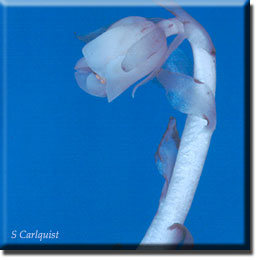 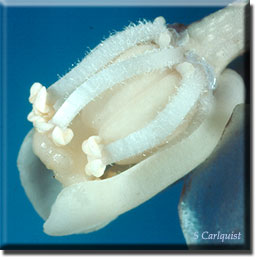
The base of a flower with the petals removed. You can see the four stub-like or root-like nectaries at the base of the hairy stamens. Notice, above, the drop of nectar.
At the tips of the stamens are the anthers, colored yellow, which contain pollen. The anthers are open and shedding pollen at this stage. The openings are like little slits. Here are two clumps of Indian Pipe plants. In the center of each clump, if you look closely, you can see young flowers, which are pointing downwards. The older flowers have turned upward. They have probably been successfully pollinated and are on the way to forming fruits. Two fruits of the Indian Pipe, Monotropa uniflora. They are dry and papery. They close up if they get wet, so the seeds are protected. When the fruits dry out, they open by slits, as shown here, and the seeds sift into the wind. 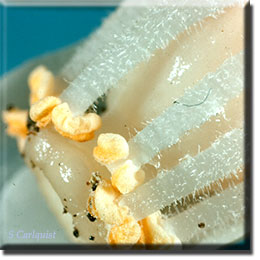 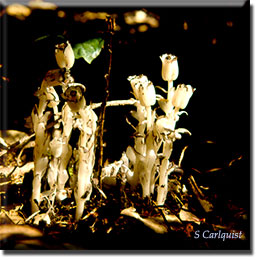 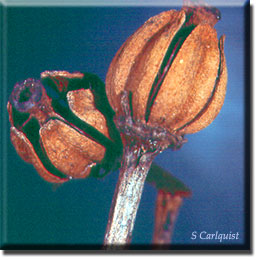 |
